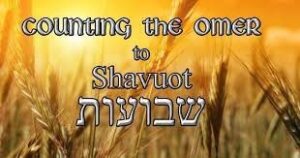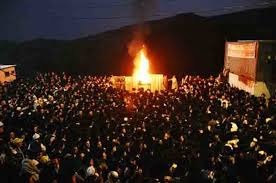Raboyseyee and Ladies,
We begin with a big mazel tov to Ariella and Zachary Grossman -our children- who were blessed with a baby boy earlier this week. May baby Grossman -to be named this coming Monday Im’H- be blessed with good health all his life, a sunny disposition, and may he be a source of joy and pride -as in nachas- to his parents, his older brother, his uncles, aunts and cousins, his grandparents -the heylige Ois and eishes chayil, to his grandparents, Karen and Allen Perl, they of Teaneck New Jersey, to his great grandmother Margo Silverman, and to his great grandparents, Ellie and Irv Bader, the shver and shvigermeister. May the good news and simchas in the family continue, omen!

Chanukah in May
Welcome to Parshas Emor where the heylige Toirah, amongst a total of 63 mitzvis spread throughout the parsha -a singleton before closing the entire Leviticus with yet another double header next week, and the most of any parsha in the entire heylige Toirah- specifically delineates the potential marriage partners of the kohanim. A healthy potion of the parsha- the last few long aliyos- is a review -as will be mentioned again below- of the many Jewish holidays we celebrate. The parsha tells us that the days between Pesach and Shovuis are known as the days of the Omer. These 49 days are counted -upward- as we anxiously await the 50th day – the great Yom tov of Shovuis – when we formally, yet metaphorically avada, married the RBSO and when we commemorate the receipt of the heylige Toirah. A wedding gift perhaps. So happens that the text of the heylige Toirah does not explicitly state that it was given to the Yiddin on Shovuis. What? On the other hand, we were taught based on simple mathematics, implicit in the text that this day -the day we now call Shouvis- is indeed the day of Matan Toirah (Revelation). Go that? Grada, the counting is directed towards a date of agricultural significance when bikurim (new fruits) would be brought to Yirusholayim on Shovuis.

Avada these were happy days, ober were they? We shall explore how these happy days become more associated with sadness and mourning just below but first a shtikel review of the first part of the parsha where the bottom line is azoy: Unlike other Jewish males who are able to marry virtually anyone -to include non-virgins, divorcees, widows, and even professional fornicators, regular kohanim and especially the koihen godol (high priest) were extremely limited in their choices. What’s pshat were? Isn’t the heylige Toirah forever? Nu, it so happens that of late -the last 20 or so years or so but who is counting- our rabbis have succumbed to the pleas of certain kohanim, and found creative ways for rewriting this commandment and thereby permitting the koihen to remarry at least one -mistama more- from the previously forbidden list. In today’s times, it is seemingly possible to marry a divorcee. One more time: Though previously married -many with children but even without- but now divorced, in our times, rabbis have found loopholes to suggest that the entire marriage was not a real marriage. What was it? A legal sham! The marriage wasn’t kosher from the get-go (pun intended). They have found ways to delegitimize the witnesses and without kosher witnesses, the contract was never valid and shoin. The kids from the sham marriage are of course kosher and all else was givaldig but those damn witnesses, may they be blessed, have changed the world. Thus, the woman of the koihen’s desires was never really married. Brilliant! What next? The marriage is annulled; it wasn’t kosher and therefore never took place; Fartig. Is the broken virginity also discounted; may she then marry a kohein godol? As a result, the koihen in our example, is free to marry the love of his life though she had a kisuva (marriage contract), a get (bill of divorce) and was likely milking the ex-husband for monthly allowance and more. And that’s what the Ois calls progressive rabbis; trying to solve contemporary issues without specifically violating Toirah laws. Why they haven’t fixed the two-day Yom tov calendar issue, ver veyst? We have -in the 12 prior years of these amazing posts- covered this topic and let us move on.

How can we properly review and cover the 63 mitzvis Parshas Emor which include serious mention of just about every single Jewish Yom Tov and according to some, even Chanukah which was not proclaimed until over one thousand plus years later- in one short overview? We cannot. What to do? Ober before we move on, did the Ois just mention that Chanukah -a holiday proclaimed to recall the eight days of the miracles that took occurred over a thousand years later, in the years 3621–3622 (140–139 BCE) is referenced mamish in our parsha? He did! How is this shayich (possible)? And the answer raboyseyee is azoy: The RBSO is above the limitations of time; case closed. Want more? It’s taka emes that Chanukah Is not specifically mentioned, ober our sages tells us that He included it in His heylige Toirah though allusions to Chanukah. Several are cited by different sources; pick the one that talks to you.
In Sefer Bamidbar (Perek 23), the heylige Toirah describes the different holidays. Immediately afterwards, at the beginning of chapter 24, we find the commandment to light the menorah in the Temple. According to some, this is a hint to a holiday connected to the lighting of the menorah on Chanukah. Not convinced? Let’s try this: in the seventh perek of Bamidbar (Parsha Nosi), the parsha describes the korbonis (offerings) that the tribal leaders brought when the Tabernacle was dedicated. The very next Perk begins with this: “The RBSO spoke to Moishe, saying: Speak to Aharoin and say to him, ‘When you light the lamps, the seven lamps shall cast their light toward the face of the menorah.’” Thus we see a connection between the dedication of the Temple and the lighting of the menorah. After the Maccabean war ended, the Yiddin cleaned, repaired and rededicated the Temple, and lit the menorah once again. Gishmak. Let’s try one more: When the Yiddin traveled in the midbar, on their way from Egypt to the land of Israel, the twenty-fifth place that they camped out at (“rested”) was Chashmonah. This alludes to the priestly family of Chashmonaim (Hasmoneans), who led the Maccabee armies in the battle against the Greeks, and who rested on the twenty-fifth day of Kislev. Gishmak and shoin. Chanukah is referenced in our parsha. Go argue! As to Chanukah itself, and somewhat out of season here in early May (the month of Iyar), we are taught azoy: when the miracle of the oil occurred in 139 BCE, the Yiddin naturally celebrated. Our rabbis of yore then proclaimed that these eight days should become an annual holiday on the Jewish calendar. So on the next year, 138 BCE, Chanukah was celebrated for the first time—complete with the lighting of the Chanukah Menorah. When was that? The heylige Toirah was given -but not yet completed in 2448. Moishe finished it in 2488 (after creation). The year was (1273 BCE). The Chanukah miracles occurred over a thousand years later, in the years 3621–3622 (140–139 BCE). Veyter.
Raboyseyee, this coming Monday evening -approximately 12 hours after the bris of new grandson and just as we daven the evening prayer- Lag B’oimer – literally meaning the 33rd day of the Oimer will be marked on the ever-shrinking sefira calendar as discussed mamish last week. Chances are excellent that no matter how little you paid attention in yeshiva for all the years you sat there throwing spit balls at the rebbe, daydreaming about girls and whatever else occupied your minds back then, you know about this happy day.
It’s the day we may, after a few weeks of a shtikel mourning period – a very small shtikel and very little mourning- listen to music, make and attend weddings and get haircuts. Ober do any of you recall what happened on this day? Why is this day so special? Nu, as a public service to my readers and because some of you remain traumatized when recalling your rebbe’s attempts to hold your bow and get your arrow straightened out, if you chap, let’s learn about this day. Here’s some background. Let’s meet Rebbe Akiva.
Says the heylige Gemora (Yevomis 62b), azoy: Rebbe Akiva had twelve thousand pairs of students and avada most anyone will tell you that a pair = two, and 12,000 pairs = 24,000 talmidim. Shoin. All agreed? Not! Why not? Because in one medrish (Medrish Rabba, Bereishis 61:50), the word “pairs” does not appear. This would suggest that he had but twelve thousand students in total. Was the medrish concerned that certain people -especially in hyntige mishugine tzeytin (today’s crazy times) one would get the wrong idea when reading about pairs of yeshiva bochirim (students)? Could be.
Just who was this Rebbe Akiva and how did he build such a large yeshiva? In our times we give plaudits to certain founders and builders when the roster nears 600-1000, ober 12,000 or 24,000 students? Was it tuition free? Other incentives? What do we know? Rebbe Akiva -we are taught- came from a family of converts. Until about 40ish, he was a complete Am ho’oretz (ignorant Jew), a total oisvorf, and worse. Later in life, he admitted that earlier in life, he abhorred the scholars of his time. Ring familiar? Ober, he fell in love with a girl named Rochel and wanted to marry her. Her father, quite a wealthy man, wasn’t very pleased with the idea that his tuchtur (daughter) would marry a lowly shepherd (which he was), an ignorant to boot, and disowned them both. The fact that our forefather Yaakov, Moishe Rabaynu and others to include Dovid Hamelech were all in the same profession didn’t at all impress him. Ober love conquers all! Rochel loved Akiva and Akiva loved Rochel mamish, and shoin. The girl from a rich home left it all behind; certainly, she was brazen. Seemingly she had a real pair, if you chap. She inspired him to learn the heylige Toirah and become educated; what wouldn’t a fellow do for a girl, especially one from money? Some say that Rochel’s father, Kalba Savua, was the wealthiest Jew of his time. Veyter.
Akiva enrolled at the Yeshiva of Rebbe Eliezer where, while pondering the world’s problems, he observed a stone that had been worn away by the drops of water that were constantly falling on it. From this episode he figured out that were he to apply himself, even at age 40, very slowly, each drop of heylige Toirah would eventually enter his farshtupta kup (stuffed head). And so it did. Roll forward some years where the story picks up. Rebbe Akiva, now with a reputation as the greatest scholar of his time, and with tens of thousands of students under his tutelage, returned to his eishes chayil and guess what? The shver, previously obstinate about the shidduch, now embraced his daughter and son-in-law and mistama left them a large yirusha (inheritance). Eventually most in-laws come around. The bottom line: ever since, parents, teachers and others tell late bloomers and converts that it’s never too late to start learning and absorbing the heylige Toirah. Another bottom line: Rebbe Akiva and Rochel lived happily ever after; inspirational mamish. The end? Not!
What happened next? We are taught that nice as he was, and an excellent rebbe, we read that his twelve or twenty-four thousand talmidim were epes not as nice. Exactly what that means, ver veyst? According to some -but not all- the RBSO got angry with them and they all died in the days and weeks between Pesach and Shovuis. How did they die? Said Rebbe Nachman: they died by suffocation from a croup-like illness. Is that what happened? Ver veyst! The heylige Gemora cites a source from the tanna’im that the students perished during the sefira period, in between Pesach and Shavuois. A shtikel later the Gemora writes that they taka died from illness, ober from the Yerushalmi (another version of the Talmud, this one authored in Jerusalem, as opposed to the Babylonian version we mostly refer to) it appears that they died in the Bar-Kochba revolt. What? They didn’t die because they weren’t quite as nice as they should have been? Not because they didn’t honor and properly respect each other? nice guys? Which is it? Ver veyst? Interestingly enough, there is mamish no mention about Lag B’oimer in this context, implying that the deaths occurred throughout the entirety of the sefira period. Moreover, this passage makes no indication of any practices of mourning to be observed to mark this tragedy. Oib azoy (if that’s true) how taka did the tradition as we know it take off? Did it begin as a fable and turn into its own reality? Did facts on the ground turn fable into fact? Grada, we see this daily when watching TV, Twitter, and other places where fake news becomes real.
It gets better. We are taught that the students -according to this shita (version or tradition) stopped dying on the 33rd day of the Omer, the day, we -in our times- call lag b’omer. That day is -as mentioned in the opener- begins Monday evening and is marked all day Tuesday until the evening. And for that reason -if true- we celebrate and party hearty. The bottom line: according to this tradition, Rebbe Akiva’s students began dying around the time we begin counting the Omer, stopped dying for a 24-hour period and resumed dying for another few weeks. Quite amazing.
Next: Following the death of his students, the somewhat in better financial shape Rebbe Akiva started over and began teaching other students. One of his foremost students was Rebbe Shimon bar Yochai, the author of the Zoihar, which deals with the mystical teachings of the Toirah and is the basis for Kabbala, whose secrets, some say, will one day bring about the coming of Moshiach. Why not? Amazingly enough, he too died on Lag B’oimer, and to remember him on this day, some people light bonfires and sing songs in his honor.

Marking the passing of this great sage is celebrated with fires, dancing, concerts and much more? What’s pshat? Shouldn’t the observance of a great sage be marked with sadness? So happens that the Ois has a friend (let’s call him Boruch Singer) who will not attend a weeding during a yurtzeit, yet Lag B’oimer and the yurtzeit of a sage is marked by celebratory festivities? What’s pshat? We are taught azoy: it’s taka emes that the death of a great sage is typically not marked with rejoicing, rather with sadness, ober we treat Rabbi Shimon bar Yochai differently. The Zoihar in Parshas Ha’azinu tells us that on the day Rabbi Shimon passed away, a great light of endless joy filled the day, because of the secret wisdom he revealed to his students. That secret wisdom was written down and recorded in the holy Zoihar. The happiness on that day was to him and his students like that of a groom while standing under the canopy at his wedding, or later that night, if you chap. On that day, the sun did not set until Rebbe Shimon had revealed all that he was permitted to. As soon as he was done, the sun set, and his soul returned to its Maker. Because of the happiness back then, we celebrate with happiness now as well. Gishmak! Emes? Why not? Go prove otherwise.
In Israel, people flock by the tens of thousands- to his grave in the city of Meron. There the day features dancing, singing, rejoicing, free parking, drinks, bonfires and haircuts. In fact, everything goes down in Meron on Lag B’oimer except for taking a shower; seemingly this is verboten. Many people wait until their son is three before cutting his hair, and on Lag B’oimer of his third year, they cut the boy’s hair. There is also a custom for children to play with bows (“keshes” in Hebrew) on Lag B’oimer. What’s pshat? One reason given is that in all the days of Rebbe Shimon bar Yochai’s life, a rainbow was never seen. A rainbow -we were taught- is a sign that the world was due for a flood. Not stam azoy a flood as many parts of the country has seen of late, including Ft. Lauderdale Florida over Pesach and even over in Los Angeles these past few months. We’re talking about a flood of biblical proportions; Noiach times flood like conditions. However, because the RBSO promised Noiach that such a flood would never be brought again, the RBSO lets us know when we are deserving of such punishment by placing a rainbow in the sky.
Another pshat: Some say that we mark this as a happy day because on this day, the students of Rebbe Akiva did not die. Is this a good enough reason to make bonfires, have outings and be joyous? Ober, asks the heylige Ois azoy: if its taka emes that people were dying by the thousands daily but stopped for that one day but resumed the next and did so until Shovuois, should we be out celebrating? Shouldn’t that day have been set aside for burying the dead and making shiva calls? What’s pshat here? What happened? And the answer? Ver veyst!
The bottom line question is azoy: did Rebbe Akiva’s students die as a result of poor behavior amongst themselves? Or, did they perish as a result of other factors? Who dun it and why? Says the classic “Aruch HaShulchan, azoy: the tragedy of the students of Rebbe Akiva is connected with the crusades, pogroms and blood libels that occurred a thousand years later in the course of Jewish history. These attacks were often rooted in a twisted Christian perspective of the Pesach ceremony, and the days after Pesach became a time of peril for the Yiddin in Christendom. These days of sefira are described as well-established days of “judgement.” And the bottom-line answer is azoy: what really went down in the days of the Omer, the days between Pesach and Shovuis with a one day break for Lag B’oimer, ver veyst? One more thing: when a tradition takes hold in our glorious religion, rumors and fable can and do -at least a times- become facts on the ground. It’s just how the world works.

Why not recall the words of Rebbe Akiva who made a guest appearance in last week’s parsha and was quoted by Rashi when pontificating on the great mitzvah of Viohavto lerayachco komocho (thou shalt love thy neighbor as thyself). Said Rashi azoy: zeh klall godol batoirah (Rebbe Akiva says that loving your neighbor (unless she’s married) as yourself, is a klall godol batoirah (an important Toirah principle). On the other hand, according to some, for his students, the klall godol was Batoirah – only in the Toirah, though not practiced in real life. And therein lies the lesson.
A gitten Shabbis-
The Heylige Oisvorfer Ruv
Yitz Grossman
